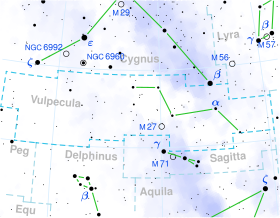30 Vulpeculae
| Observation data Epoch J2000 Equinox J2000 | |
|---|---|
| Constellation | Vulpecula |
| Right ascension | 20h 44m 52.50440s[1] |
| Declination | 25° 16′ 14.2162″[1] |
| Apparent magnitude (V) | 4.91[2] |
| Characteristics | |
| Spectral type | K1III[3] |
| U−B color index | +1.18[2] |
| B−V color index | +1.19[2] |
| Astrometry | |
| Radial velocity (Rv) | +30.00[4] km/s |
| Proper motion (μ) | RA: -29.06[1] mas/yr Dec.: -177.96[1] mas/yr |
| Parallax (π) | 10.04 ± 0.47 mas[1] |
| Distance | 320 ± 20 ly (100 ± 5 pc) |
| Absolute magnitude (MV) | -0.07[3] |
| Details | |
| Luminosity | 156[3] L☉ |
| Surface gravity (log g) | 2.47[5] cgs |
| Temperature | 4,490[5] K |
| Metallicity [Fe/H] | -0.10[3] dex |
| Rotational velocity (v sin i) | < 1.5[6] km/s |
| Other designations | |
| Database references | |
| SIMBAD | data |
30 Vulpeculae is a class K1III[3] (orange giant) star in the constellation Vulpecula. Its apparent magnitude is 4.91[2] and it is approximately 325 light years away based on parallax.[1] It is a spectroscopic binary with an orbit around 2506 days.[7]
References
- ^ a b c d e f Van Leeuwen, F. (2007). "Validation of the new Hipparcos reduction". Astronomy and Astrophysics. 474 (2): 653. arXiv:0708.1752. Bibcode:2007A&A...474..653V. doi:10.1051/0004-6361:20078357. Vizier catalog entry
- ^ a b c d Ducati, J. R. (2002). "VizieR Online Data Catalog: Catalogue of Stellar Photometry in Johnson's 11-color system". CDS/ADC Collection of Electronic Catalogues. 2237. Bibcode:2002yCat.2237....0D.
- ^ a b c d e Anderson, E.; Francis, Ch. (2012). "XHIP: An extended hipparcos compilation". Astronomy Letters. 38 (5): 331. arXiv:1108.4971. Bibcode:2012AstL...38..331A. doi:10.1134/S1063773712050015. Vizier catalog entry
- ^ Famaey, B.; Jorissen, A.; Luri, X.; Mayor, M.; Udry, S.; Dejonghe, H.; Turon, C. (2005). "Local kinematics of K and M giants from CORAVEL/Hipparcos/Tycho-2 data". Astronomy & Astrophysics. 430: 165. arXiv:astro-ph/0409579. Bibcode:2005A&A...430..165F. doi:10.1051/0004-6361:20041272.
- ^ a b Soubiran, Caroline; Le Campion, Jean-François; Brouillet, Nathalie; Chemin, Laurent (2016). "The PASTEL catalogue: 2016 version". Astronomy & Astrophysics. 591: A118. arXiv:1605.07384. Bibcode:2016A&A...591A.118S. doi:10.1051/0004-6361/201628497.
- ^ De Medeiros, J. R.; Mayor, M. (1999). "A catalog of rotational and radial velocities for evolved stars". Astronomy and Astrophysics Supplement Series. 139 (3): 433. arXiv:astro-ph/0608248. Bibcode:1999A&AS..139..433D. doi:10.1051/aas:1999401. Vizier catalog entry
- ^ Pedoussaut, A.; Carquillat, J. M.; Ginestet, N.; Vigneau, J. (1988). "Spectroscopic binaries - 15th complementary catalog". Astronomy and Astrophysics Supplement Series. 75: 441. Bibcode:1988A&AS...75..441P.

